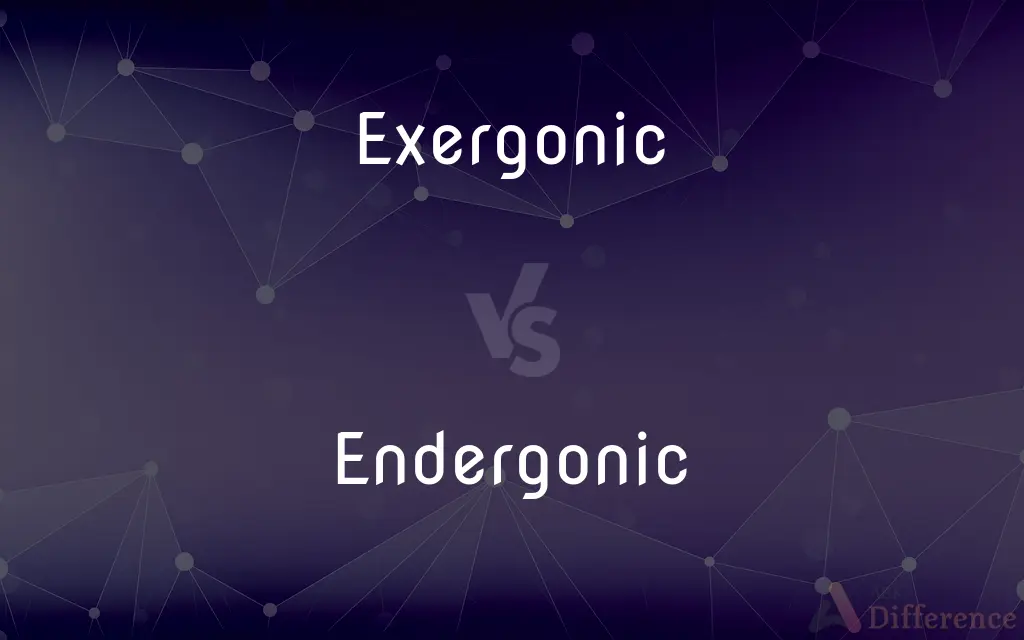Exergonic vs. Endergonic — What's the Difference?
By Tayyaba Rehman & Urooj Arif — Updated on April 22, 2024
Exergonic reactions release energy and generally occur spontaneously, whereas endergonic reactions require energy input and are non-spontaneous.

Difference Between Exergonic and Endergonic
Table of Contents
ADVERTISEMENT
Key Differences
Exergonic reactions involve the release of energy to the surroundings, typically resulting in an increase in entropy or disorder. Whereas endergonic reactions absorb energy, usually leading to a decrease in entropy.
In exergonic reactions, the Gibbs free energy change (ΔG) is negative, indicating a spontaneous process. On the other hand, in endergonic reactions, ΔG is positive, reflecting the need for energy input for the reaction to occur.
Exergonic reactions are often catabolic, breaking down complex molecules into simpler ones and releasing energy useful for cellular activities. Endergonic reactions, by contrast, are typically anabolic, building complex molecules from simpler ones, requiring energy input.
Many biological processes depend on the coupling of exergonic and endergonic reactions, where the energy released by an exergonic reaction drives an endergonic one. This coupling is crucial for the energy economy of cells.
While exergonic reactions might proceed quickly due to the spontaneous release of energy, endergonic reactions often require the presence of enzymes to proceed at a significant rate as they overcome higher energy barriers.
ADVERTISEMENT
Comparison Chart
Energy Change
Release energy
Absorb energy
Gibbs Free Energy (ΔG)
Negative (ΔG<0)
Positive (ΔG>0)
Spontaneity
Spontaneous
Non-spontaneous
Common Processes
Cellular respiration, combustion
Photosynthesis, synthesis of complex molecules
Entropy Change
Typically increases (more disorder)
Typically decreases (less disorder)
Compare with Definitions
Exergonic
Often linked to spontaneous processes.
The spontaneous rusting of iron is an exergonic process.
Endergonic
Non-spontaneous without energy input.
The creation of peptide bonds in protein synthesis is an endergonic reaction.
Exergonic
Characterized by negative Gibbs free energy.
The breakdown of glucose in cells is exergonic with ΔG less than zero.
Endergonic
Common in anabolic pathways.
Building muscle mass through protein synthesis is an endergonic activity.
Exergonic
A reaction where energy is released.
Combustion of wood is an exergonic reaction that releases heat.
Endergonic
Characterized by positive Gibbs free energy.
The formation of starch from glucose is endergonic with ΔG greater than zero.
Exergonic
Common in catabolic pathways.
The cellular breakdown of proteins into amino acids is an exergonic process.
Endergonic
Typically decreases entropy.
The ordering of molecules in crystal formation is an endergonic process that reduces entropy.
Exergonic
Typically increases entropy.
The decomposition of organic matter increases entropy in an exergonic manner.
Endergonic
A reaction that absorbs energy.
The synthesis of glucose in plants is an endergonic process.
Exergonic
Releasing energy.
Endergonic
Requiring energy
An endergonic chemical reaction.
Exergonic
Releasing energy (especially as heat)
Endergonic
(chemistry) Describing a reaction that absorbs (heat) energy from its environment
Common Curiosities
What is an exergonic reaction?
An exergonic reaction is a chemical process where energy is released to the surroundings and has a negative Gibbs free energy.
Why are enzymes important for endergonic reactions?
Enzymes lower the activation energy of endergonic reactions, making it feasible for these energy-absorbing processes to occur under cellular conditions.
Can exergonic and endergonic reactions occur simultaneously?
Yes, in biological systems, exergonic and endergonic reactions often occur simultaneously, where the energy released by exergonic reactions is used to drive endergonic reactions.
What are some examples of exergonic and endergonic reactions in everyday life?
Exergonic: combustion in engines; Endergonic: electrolysis of water.
What is an endergonic reaction?
An endergonic reaction is a chemical process that absorbs energy from its surroundings and has a positive Gibbs free energy.
How are these reactions measured in a laboratory setting?
The changes in Gibbs free energy (ΔG) are measured to determine whether reactions are exergonic or endergonic. Calorimetry can be used to measure the heat released or absorbed.
Are all exergonic reactions fast?
Not necessarily; while exergonic reactions are thermodynamically favorable, their rate depends on activation energy, which can require the presence of catalysts to proceed rapidly.
Can endergonic reactions ever become exergonic?
An endergonic reaction can become exergonic under different conditions, such as changes in temperature, pressure, or through coupling with a more energy-releasing exergonic reaction.
What role do ATP and ADP play in these reactions?
ATP (adenosine triphosphate) often provides the energy needed for endergonic reactions by releasing energy upon its conversion to ADP (adenosine diphosphate), which is an example of an exergonic reaction.
How does the law of conservation of energy apply to these reactions?
Both reaction types adhere to the law of conservation of energy, either releasing stored energy or storing absorbed energy, but neither creates nor destroys energy.
How do temperature changes affect exergonic and endergonic reactions?
Temperature increases can enhance both exergonic and endergonic reactions by providing the kinetic energy needed to overcome activation barriers, though their effects on reaction spontaneity vary based on entropy changes.
How do enzymes affect the Gibbs free energy of a reaction?
Enzymes do not change the Gibbs free energy (ΔG) of a reaction but lower the activation energy, making it easier for the reaction to proceed.
What is a coupled reaction in biochemical terms?
A coupled reaction involves linking an endergonic reaction with an exergonic reaction so that the energy released by the latter drives the former, common in cellular processes like ATP synthesis.
What is the importance of these reactions in metabolism?
Metabolic pathways rely on the balance of exergonic and endergonic reactions to sustain life, managing energy resources efficiently to support growth, reproduction, and maintenance.
What are practical applications of understanding these reactions?
Practical applications include the design of bioenergetic drugs, optimization of fermentation processes, and the development of sustainable energy solutions.
Share Your Discovery

Previous Comparison
Bee vs. Cat
Next Comparison
Nightclub vs. CasinoAuthor Spotlight
Written by
Tayyaba RehmanTayyaba Rehman is a distinguished writer, currently serving as a primary contributor to askdifference.com. As a researcher in semantics and etymology, Tayyaba's passion for the complexity of languages and their distinctions has found a perfect home on the platform. Tayyaba delves into the intricacies of language, distinguishing between commonly confused words and phrases, thereby providing clarity for readers worldwide.
Co-written by
Urooj ArifUrooj is a skilled content writer at Ask Difference, known for her exceptional ability to simplify complex topics into engaging and informative content. With a passion for research and a flair for clear, concise writing, she consistently delivers articles that resonate with our diverse audience.














































